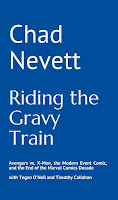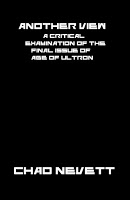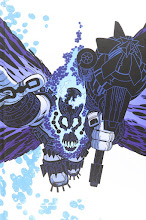[Discussed in this post: Hellblazer #25 ("Early Warning"), 26 ("How I Learned to Love the Bomb"), and 56 ("This is the Diary of Danny Drake").]
"Early Warning" and "How I Learned to Love the Bomb" comprise the two-part story Grant Morrison wrote for the book. They were reprinted in Rare Cuts primarily on the strength of his name, not being the most amazing comics ever published. They're not bad issues in any sense and they show some of his interests coming to the surface. John heads North to Thursdyke, a town afflicted with poverty after a mine shut down, and, now, is holding a pagan carnival celebration as a sort of town spirit, let's all pull together thing. John only goes because he was invited by Una, a woman he knew from Ravenscar. She's a journalist now, no longer hearing voices when she takes her pills. The story revolves around an American military base in the area that no one really likes, but the people of Thursdyke tolerate because it means some jobs. There's a scene in a bar where a protestor from London and a local get into an argument over the base, while the story has numerous references to Margaret Thatcher's term as Prime Minister. This clearly fits into Morrison's period of social activism in his writing, of exploring issues that meant a great deal to him personally openly and directly in his writing.
At the same time, we get a glimpse of something going on in the base: a doctor running certain experiments and turning on his machine. The dialogue here is suggestive and creepy with implications about science being the new religion/magic. The doctor turns on his machine, which sends out an audio signal at a frequency that unleashes all human desires and inhabitions. The town goes wild with people killing, raping, torturing, what have you. (On a side note, this sort of thing happens a lot in Hellblazer. I'm quite glad I don't live in this universe for all of the times that entire populaces just go crazy and do this sort of thing.) This happens during the carnival parade, which means these gortesque masks that make for great visuals. The first issue ends with John joining in by putting on a Thatcher mask.
In the second half of the story, we learn that the doctor is somehow powering his machine without any technology. Budget cuts, you see, necessitated him to do something else. Meanwhile, Una stops John from leading everyone into the water to their deaths as she wasn't affected because of her headphones (Sonic Youth on her walkman). They realise what's going on: the local priest has become Archbishop Bomb and is leading a group of people to the military base to blow up some of the nuclear weapons there. John rushes to stop them, using a van with a PA system to broadcast Sonic Youth and drown out the signal. He's too late, though, as Archbishop Bomb steals a plane and bombs the town. The issue ends with John surviving, making sarcastic comments to a newscaster who was putting forth the party line that anti-nuclear protestors were responsible, and heading back south.
The magic connection is tenuous, but that's not essential. John isn't much of a presence here and doesn't have a distinct personality really. He's more a supporting character driven to action by events. Which is fine. It's a perfectly fine, inessential story. It has a good, creepy style because of Morrison's writing and David Lloyd's art.
"This is the Diary of Danny Drake" is a similarly inessential story where John sees a man on the subway just blurt out that he likes to have sex with prostitutes. He's curious and discovers that the man, Danny Drake, thinks he's being haunted by his diary. Turns out that it's just a demon having fun with him as the end of his contract with her approaches. He sold his soul for success and, then, killed his pregnant wife (selling his unborn child's soul) for an extension five years previously. John stops him from sacrificing another baby, having figured it all out, leaving Danny Drake to be taken to Hell. A good little self-contained story in that typical Hellblazer way. Usually, for these one-off stories, John is just a presence in something outside of him, getting to be a guy who knows shit, and solves the problems. There's often a twist like this guy selling his soul and being a right bastard.
All three of these issues were drawn by David Lloyd, most well-known in the US for V for Vendetta with Alan Moore. There's a soft, suggestive quality to his art in the Morrison two-parter. I don't know entirely how to describe it, but it's a soft encroaching of shadows around the edges of most of his figures. His art has a harder edge in the Ennis issue. That he colours himself gives the art a strong presence. He really plays with the absurd imagery in the Morrison story with the carnival masks. Those drawings are just flat-out funny while also being horrific. In the Morrison story, he also uses layouts well, switching to diagonal panel borders when the signal takes hold of the town. A pretty simple but effective visual trick.
In 30 minutes, we start Garth Ennis's run proper with Dangerous Habits, which many consider to be the best Hellblazer story of all...
[Don't forget to donate what you can to the Comic Book Legal Defense Fund! After you do, let me know via comment or e-mail (found at the righthand side) so I can keep track of donations -- and who to thank.]
skip to main |
skip to sidebar
"Chad Nevett is the spicy mustard of comics reviews" -- Adam Langton, Lovable Fucker and Chad Nevett's Best Man
About
GraphiContent was a blog featuring comic criticism, commentary, analysis, theory and discussion. Oh, and the odd rant, review or totally random post.
Chad Nevett has a BA in English and political science, and an MA in English Language & Literature--Creative Writing. He was a reviewer for Comic Book Resources, blogger for Comics Should be Good, and writer for 411mania. He resides in Windsor, Ontario with his wife and her cat. He can be reached at chevett13[at]yahoo[dot]ca.
Notable Posts (In Chronological Order)
- The Future is X-Rated: Marvel Boy, the Modern World, and the History of the Marvel Universe
- A Music Video on Paper: The Final Chapter of Codeflesh
- Tony Stark, Futurist
- "All you need is fuck."
- Man v. Superman
- Civil War v. Infinite Crisis
- Building a Better Batman: Grant Morrison's First Year on Batman
- U.S. v. T.H.E.M. with Little Ol' Me Stuck in the Middle
- Mark Millar's Ultimate X-Men
- Building a Better Batreader: Grant Morrison's Second Year on Batman
- Secret Invasion Reading Order (Updated June 29, 2013)
- Top 25 Warren Ellis Comics (Oct. 2009)
- Building a Better Batfamily: Grant Morrison's Third Year on Batman (and Robin)
- You Don't Just Want to Break Me, You Want to Tear Me Apart
- 50 Things I Learned in My Three Years and Four Months as a Reviewer for Comic Book Resources
- Avengers vs. X-Men Reading Order (Updated August 17, 2013)
Notable Collections of Posts (In Semi-Chronological Order)
- Joe Casey Comics Archive
- Countdown to Who Cares?
- The Chad and Steve Q&A Series
- I've Got 52 Problems, but a Bitch ain't One
- Best of 2007
- Hello Cosmic: The Works of Jim Starlin Archive
- Chad's Jackass Comic Creator Interviews from 2001
- The Superman 2000 Pitch (with Tim Callahan)
- Raymond Chandler's "Twelve Notes on the Mystery Story"
- Best of 2008
- Blogathon 2009: Brian Michael Bendis's Avengers
- Best of 2009
- Art Discussion Month 2010
- Five Years Blogging: A Life Well Wasted (with David Brothers)
- Booze, Broads & Bullets: Sin City
- Blogathon 2010: Hellblazer (and Hellblazer Posts Beyond the Blogathon)
- Best of 2010
- 28
- Blogathon 2011: Superhero Comics of the Past Decade
- Best of 2011
- Riding the Gravy Train (Avengers vs. X-Men) Archive
- Blogathon 2013: Comics Critics All-Stars
- Best of 2012
Links
Blogs Worth Reading
-
-
Dead X-Men #4 annotations16 hours ago
-
-
-
-
The Mighty Crusaders Number Four #031 month ago
-
The Last Thorsday1 month ago
-
Everybody’s Rockin’6 months ago
-
-
Social (Science) Fiction8 months ago
-
The Rest of the Cruise1 year ago
-
-
-
-
Untitled 1:5 years ago
-
Farewell, sweet prince6 years ago
-
Hello World6 years ago
-
-
-
That’s a wrap.9 years ago
-
episode 026: exit the world10 years ago
-
-
Books Read in 201211 years ago
-
Building Stories - Suggested Reading Order11 years ago
-
Final Crisis #715 years ago
-
Riding the Gravy Train: Avengers vs. X-Men, the Modern Event Comic, and the End of the Marvel Comic
Another View: A Critical Reading of the Final Issue of Age of Ultron
GØDLAND CELESTIAL EDITION THREE
Shot in the Face: A Savage Journey to the Heart of Transmetropolitan
Keeping the World Strange: A Planetary Guide
Minutes to Midnight: Twelve Essays on Watchmen
Writing Without Direction: 10 1/2 Short Stories by Canadian Authors under 30
Blog Archive
-
▼
2010
(544)
-
▼
July
(94)
- CBR Review: First Wave #3
- CBR Review: Thor #612
- CBR Review: Puinishermax #9
- CBR Review: Secret Avengers #3
- CBR Review: After Dark #1
- CBR Review: Wonder Woman #601
- Quickie Reviews (July 28 2010)
- The Splash Page Podcast Special Guest Episode 1
- CBR Review: Darkwing Duck #2
- CBR Review: DV8: Gods and Monsters #4
- Blogathon Wrap-Up
- CBR Review: Red Mass for Mars #4
- CBR Review: X-Factor #207
- CBR Review: Atlas #3
- CBR Review: Amazing Spider-Man #638
- Quickie Reviews (July 21 2010)
- CBR Review: Daytripper #8
- CBR Review: The Man with the Getaway Face
- CBR Review: Officer Downe #1
- The Splash Page Podcast Episode 25
- Blogathon 2010 Archive Post
- Blogathon 49: "Goodnight and God bless -- now fuck...
- Blogathon 48: John Constantine
- Blogathon 47: The Artists of Hellblazer
- Blogathon 46: The Writers of Hellblazer
- Blogathon 45: Hellblazer #250
- Blogathon 44: Hellblazer #245-246
- Blogathon 43: Hellblazer #229
- Blogathon 42: Hellblazer: The Red Right Hand
- Blogathon 41: Hellblazer: Empathy is the Enemy
- Blogathon 40: Hellblazer: The Gift (Part Three)
- Blogathon 39: Hellblazer: The Gift (Part Two)
- Blogathon 38: Hellblazer: The Gift (Part One)
- Blogathon 37: Hellblazer: Reasons to be Cheerful (...
- Blogathon 36: Hellblazer: Reasons to be Cheerful (...
- Blogathon 35: Hellblazer: Stations of the Cross (P...
- Blogathon 34: Hellblazer: Stations of the Cross (P...
- Blogathon 33: Hellblazer: Stations of the Cross (P...
- Blogathon 32: Hellblazer: Staring at the Wall (Par...
- Blogathon 31: Hellblazer: Staring at the Wall (Par...
- Blogathon 30: Hellblazer: Black Flowers (Part Two)
- Blogathon 29: Hellblazer: Black Flowers (Part One)
- Blogathon 28: Hellblazer: Red Sepulchre
- Blogathon 27: Hellblazer: All His Engines
- Blogathon 26: Hellblazer: Highwater (Part Three)
- Blogathon 25: Hellblazer: Highwater (Part Two)
- Blogathon 24: Hellblazer: Highwater (Part One)
- Blogathon 23: Hellblazer: Freezes Over (Part Two)
- Blogathon 22: Hellblazer: Freezes Over (Part One)
- Blogathon 21: Hellblazer: Good Intentions
- Blogathon 20: Hellblazer: Hard Time
- Blogathon 19: Hellblazer: Shoot and Planetary #7
- Blogathon 18: Hellblazer: Setting Sun
- Blogathon 17: Hellblazer: Haunted
- Blogathon 16: Hellblazer: Son of Man
- Blogathon 15: Hellblazer #85-89
- Blogathon 14: Hellblazer: Heartland
- Blogathon 13: Hellblazer: Rake at the Gates of Hell
- Blogathon 12: Hellblazer: Damnation's Flame
- Blogathon 11: Hellblazer: Tainted Love
- Blogathon 10: Hellblazer: Fear and Loathing (Part ...
- Blogathon 09: Hellblazer: Fear and Loathing (Part ...
- Blogathon 08: Hellblazer: Bloodlines (Part Three)
- Blogathon 07: Hellblazer: Bloodlines (Part Two)
- Blogathon 06: Hellblazer: Bloodlines (Part 1)
- Blogathon 05: Hellblazer: Dangerous Habits
- Blogathon 04: Hellblazer #25-26, 56
- Blogathon 03: Hellblazer #31, 35 & 84
- Blogathon 02: Hellblazer #11
- Blogathon 01: Alright, Sunshine?
- Blogathon 2010 Tomorrow!
- CBR Review: Predators: Preserve the Game #1
- CBR Review: X-Files/30 Days of Night #1
- CBR Review: Superman #701
- Quickie Reviews (July 14 2010)
- CBR Review: The Playwright
- Blogathon 2010 Only Four Days Away!
- CBR Review: Gødland #32
- CBR Review: Sparta, U.S.A. #5
- The Splash Page Podcast Episode 24
- Blogathon 2010
- CBR Review: Demo Vol. 2 #6
- CBR Review: Batman: Odyssey #1
- CBR Review: Thor the Mighty Avenger #1
- CBR Review: The Boys #44
- CBR Review: The Great Ten #9
- CBR Review: Batman and Robin #13
- Quickie Reviews (July 7 2010)
- CBR Review: Do Androids Dream of Electric Sheep?: ...
- CBR Review: Deadpool Team-Up #892
- CBR Review: Abe Sapien: The Abyssal Plain #1
- The Splash Page Podcast Episode 23
- CBR Review: Thor #611
- CBR Review: Captain Swing and the Electrical Pirat...
-
▼
July
(94)






